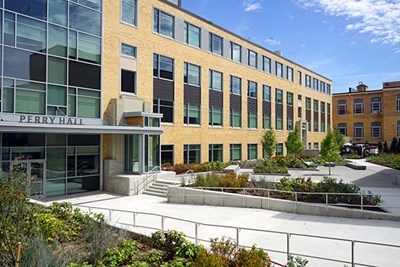Renovation Complete at South Campus ‘Gem,’ while Centers for Learning Moves to Cumnock Over Break
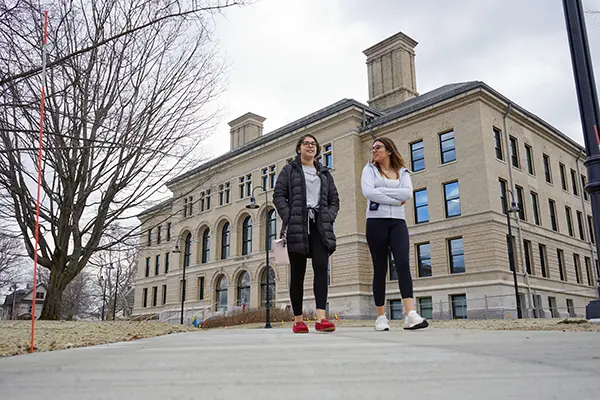 Image by Ed Brennen
Image by Ed Brennen
01/17/2020
By Ed Brennen
Out of commission for the past year and a half for a dramatic renovation, restoration and expansion, the university’s original academic building, Coburn Hall, is reopening its doors to students on South Campus for the start of the spring 2020 semester.
Facilities Management put the finishing touches on 123-year-old Coburn Hall’s $47 million renovation over winter break, one of the many projects it tackled as the university continues to renew, modernize and reconfigure existing spaces around campus to meet the needs of the growing student body.
On North Campus, the Centers for Learning and Academic Support Services (CLASS) moved to its new home in the lower level of Cumnock Hall. On East Campus, renovation work continued on the future home of the Graduate and Professional Studies Center at 839 Merrimack St., while across Pawtucket Street, a pair of vacant buildings were razed to make way for a new Northern Canal overlook park.
Here’s a closer look at the facilities work that took place around campus while students were away:
Class is back in session at Coburn Hall, which originally opened in 1897 as the home of the Lowell Normal School, a two-year teachers college. While the building’s 12 new technology-enhanced classrooms – nine on the lower level and three on the first floor – are open to all departments for the start of the spring semester, the College of Education will wait until spring break to relocate its offices from O’Leary Library to Coburn Hall’s first and second floors. The Psychology Department will move from the Health and Social Sciences Building to the third floor of Coburn Hall.
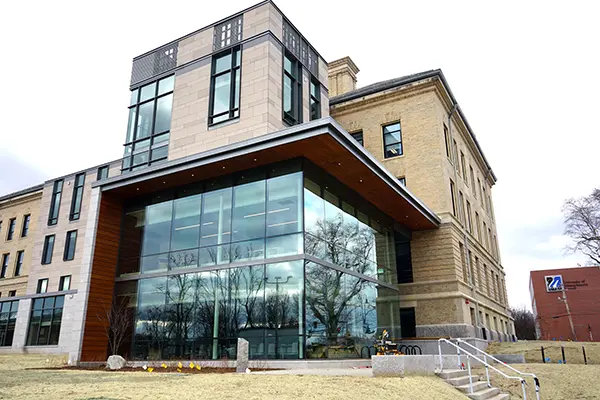 Image by Ed Brennen
Image by Ed Brennen
Chancellor Jacquie Moloney ’75 ’92, who took classes in Coburn Hall as an undergraduate sociology major and later taught in the building as a faculty member, says the renovation symbolizes the university’s path toward the future while celebrating its past.
“Knowing what a gem this building was and what it means to this university, to see this today is just so exciting,” Moloney says.
Coburn Hall is now fully accessible, thanks to the addition of an elevator and a universal path in front of the building that leads to a reconfigured main entrance. This required pulling the front steps away from the front of the building (where glass doors were integrated into the arched entryway) and regrading the landscaping.
“It’s a very elegant solution to making the historic front entrance accessible,” says Executive Director of Planning, Design and Construction Adam Baacke, who credits CBT Architects for their design work.
The most noticeable element of the project is a four-story, 14,000-square-foot addition at the rear of the existing 60,000-square-foot building. Besides providing an accessible entrance to Coburn Hall’s lower level, the addition includes a second-floor hallway (lined with offices) that provides an accessible “bridge” between the building’s two wings. The original rear wall of the building, with its arched windows and yellow, iron-spot brick, was preserved and now provides a striking interior design element that’s visible from all four floors of the addition.
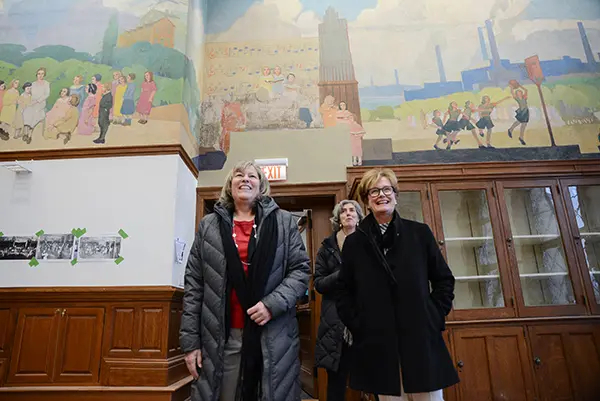 Image by Tory Wesnofske
Image by Tory Wesnofske
Coming in the main entrance, the first-floor lobby’s original terrazzo flooring has been restored after being hidden beneath a layer of tiles for decades. The stained-glass window that faced guests entering the lobby was moved down the hall to make way for a large picture window, which offers a view into a model elementary school classroom. There, education majors can practice teaching on computerized student avatars.
“Teaching is something that should be seen and shared, so we wanted to make this model classroom as visible as possible,” says College of Education Dean Eleanor Abrams, who believes the new Coburn Hall will be “one of the best buildings for a college of education” in the state.
On the second floor, Coburn Hall’s grand ballroom has been converted into a flexible event space, with the rear third of the room partitioned off for seminar and meeting rooms. A 1934 WPA-era mural depicting students, teachers and the Lowell skyline, which had been painted over nearly 40 years ago, is also being restored along the ballroom’s west wall. A pair of smaller, matching murals in the main lobby depicting Lowell's mill girls have also been refreshed.
Every classroom in Coburn Hall has been updated with the latest instructional technology, and there is also a new 36-seat Technology Enhanced Active Learning (TEAL) classroom on the lower level. Even the building’s floors are innovative – a woven-plastic flooring called Chilewich, which resembles carpet but is much easier to clean, was used for the first time on campus.
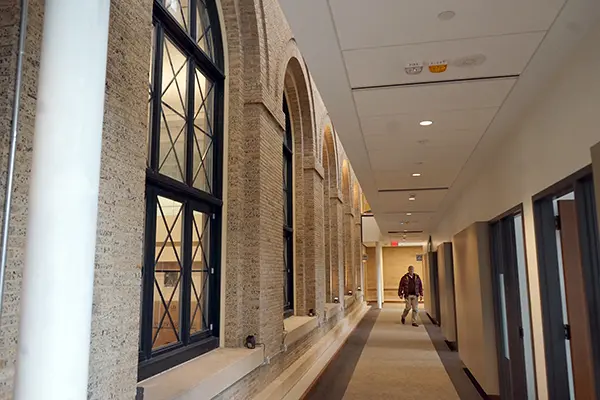 Image by Ed Brennen
Image by Ed Brennen
With the addition of a centralized air-conditioning system, energy-efficient LED lighting, occupancy sensors and low-flow plumbing, Coburn Hall is expected to receive LEED Silver certification.
“The fact that you took a building that’s over 100 years old and made it LEED Silver is not insignificant,” Baacke says.
By consolidating the classrooms to the lower two floors, Baacke says the building’s traffic flow will be much more efficient. And whereas the building’s only restrooms used to be located in the basement, there are now student and staff restrooms on each of the four floors.
CLASS Move
Located for more than three decades at Southwick Hall, the Centers for Learning and Academic Support Services has moved to the lower level of Cumnock Hall.
“Students are going to be so thrilled with the new space,” says Executive Director of Academic Services and Special Projects Sheila Riley-Callahan, who has been with CLASS since it was founded by Moloney in 1986.
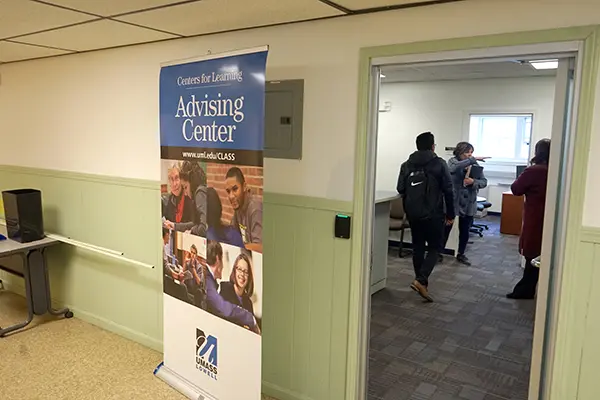 Image by Ed Brennen
Image by Ed Brennen
While CLASS is based on North Campus, it also provides students with academic advising, tutoring, testing space and more at O’Leary Library on South Campus, as well as after-hours tutoring at Fox Hall and the UMass Lowell Inn and Conference Center. Last year, students used CLASS services more than 138,000 times.
In its new location at Cumnock Hall, the Tutoring Center has expanded from four to 11 work stations, while the Testing Center has doubled its capacity from 20 to 40 desks.
The Writing Center, which provides one-on-one assistance for students on writing projects, has also moved with CLASS from Southwick to Cumnock Hall.
Riley-Callahan says the new location will be more central and convenient for students from the Kennedy College of Sciences, the Francis College of Engineering and the Manning School of Business.
The Hot Corner
The intersection of Pawtucket and Merrimack streets, in front of University Crossing, was busier than normal over winter break.
Renovation work continued at the former nursing home at 839 Merrimack St., which is scheduled to reopen in March as the university’s Graduate and Professional Studies Center. The university has signed a 10-year lease on the three-story building, which is being substantially renovated by its owner with new windows, interiors and central air-conditioning.
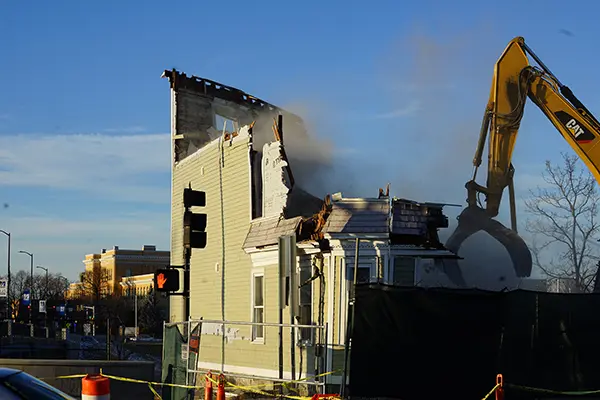 Image by Ed Brennen
Image by Ed Brennen
When finished, the Office of Residence Life and the Office of International Experiences and Study Abroad will move from UCrossing to the first floor of the building, which will also include four classrooms.
The university’s Graduate, Online and Professional Studies (GPS) program will occupy the second and third floors, as will the International Students and Scholars Office and the Navitas Global Student Success Program.
Across the street, the vacant apartment buildings at the foot of the Howe Bridge were demolished in late December. The university is working with the city to construct a park overlooking the Northern Canal, which will provide more room for pedestrian and bicycle traffic when it’s completed this spring.
Back on South Campus, just beyond the softball field’s center-field fence, work was nearly completed on the new Schueller Astronomical Observatory, which is scheduled to open this spring.



